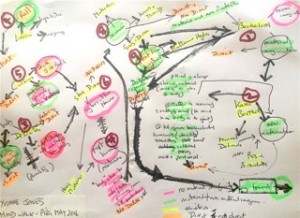Yvonne Jones
09 May 2016
Having considered Material Imagination within the group, I wanted to consider Non-Material Imagination (my words). Is there a connecting line of thought between the received image, memory and imagination, and, by implication, the mind / body interoperations? Through looking at several writers, I am asking how are the ideas related, do they interlink, overlap? Is there one indescribable that they speak of, do any of them support each other, can they be developed into a position where the non-material imagination becomes visible, and what, if it does, is the significance for living human beings today?
Bachelard speaks of images of matter, direct experience of matter, and images of form.
Imagination comes before all else, material imagination and the poetic image reverberate with the human, (go beyond data and form). Images of form are perishable, vain images and the becoming of surfaces.(Bachelard; Poetics and Reverie 1971, Poetics of Space 1969)
Descartes states ‘in infancy our mind was so tightly bound to the body as not to be open to any experience (cogitationbus) except mere feelings of what affected the body’. He creates a dualism and divide between mind and body suggesting ‘In adult life the mind is no longer wholly slave to the body and does not relate everything to that’. (Anscombe and Geach, 1954, Descartes Philosophical writings, extracts from Principles of Philosophy part 1 First Philosophy.R. LXXl, p. 196).
Lacan speaks of the Real, The Imaginary Order and Symbolic Order. Of the Real, Cussans believes it is increasingly difficult to experience, and is now only approached through trauma. He holds that the cinema was the beginning of the end of Real. (Symbolic Wounds and the Impossible Real – The Paradox of Traumatic Realism in Televisual Representations of Terror. 2003 lecture at WSA).
Steve Dixon tells us ‘The bifurcatory division between body and mind has lead to an objectified redefinition of the human subject – the ‘person’ – into an abstracted, depersonalised and increasingly dehumanised physical object.’ (Dixon, S. 2003, Adventures in Cybertheatre. IN ZAPP, A. & BERG, E. (Eds.) Networked Narrative Environments as imaginary spaces of being, Liverpool 23rd May 2003. Liverpool, FACT in association with MIRIAD/ Manchester Metropolitan University).
Moravec foretells there will be very few original experiences, (in time to come) they are mostly held as data in a huge computer ‘out there somewhere’, offering us the raw cold data of “experiences” had over the generations. (Moravec. 1997, The Senses have no Future)
Makedon states “Without a World to imagine about, there would be no-thing imaginable… that even an “impossible” world is only imaginable within the context of ‘possible imaginings’ provided by the world humans has learned about.
Unpicking aspects of the above and bringing in Garry and Polaschek (Imagination and Memory. 2000) and, Bergen, Narayan and Feldman (Embodied Verbal Semantics: Evidence from an Image-Verb Making. 2003) it opens the possibility that mind operations are not suitably evolved to clearly and reliably distinguish between images that are materially present and those that are represented to it via non-material images, photography, film, video, internet content.
This could prove an issue going forward.
